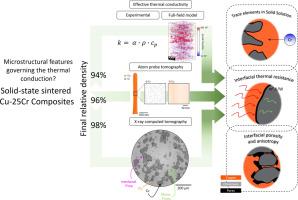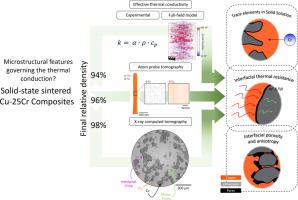控制Cu-25Cr烧结复合材料有效导热系数的微观组织特征
IF 9.3
1区 材料科学
Q1 MATERIALS SCIENCE, MULTIDISCIPLINARY
引用次数: 0
摘要
中压真空断流器是当代能源转换和电气化中高性能的断流装置。断流性能与铜铬合金电触点的性能直接相关。因此,提高Cu-Cr合金的性能以应对不断增长的对大电流、高功率和高电压应用的需求,本质上需要优化Cu-Cr合金的微观结构,以提高其导电性和导热性。在此,我们揭示了控制Cu-25Cr烧结复合材料有效热导率的微观结构特征,由于复杂的微观结构-热传导关系,这一主题的科学关注度远低于其导电性。我们将先进的三维表征技术,即x射线计算机断层扫描和原子探针断层扫描,与实验和现场数值研究相结合,对三种具有不同最终相对密度(94,96和98%)的Cu-25Cr烧结复合材料的有效导热系数进行了研究。我们论证了固溶体、界面热阻、相分布对有效导热系数的协同效应。界面孔隙阻碍了相间的热传导。由于烧结过程中固溶体中的元素在Cu基体中扩散,以及Cu/Cr相之间的界面热阻,有效导热系数也降低了。利用全场数值方法,我们揭示了微观结构非均质性引起的热通量各向异性对有效导热系数各向异性的影响。本文章由计算机程序翻译,如有差异,请以英文原文为准。


Microstructural features governing the effective thermal conductivity of Cu-25Cr sintered composites
Medium voltage vacuum interrupters are high-performance current interruption devices in the contemporary energy transition and electrification. The current interruption performance is directly correlated to the properties of their electrical contacts made of Cu-Cr alloys. Therefore, enhancing their performance to respond to the continuously increasing demand for higher current, higher power, and high voltage applications inherently requires the optimization of the microstructure of the Cu-Cr alloys to increase their electrical and thermal conductivity. Herein, we unveil the microstructural features governing the effective thermal conductivity of Cu-25Cr sintered composites, a subject of much less scientific attention than their electrical conductivity due to the complex microstructure-thermal conduction relationships. We coupled advanced 3D characterization techniques, namely X-ray computed tomography and atom probe tomography, with experimental and full-field numerical investigation of the effective thermal conductivity for three Cu-25Cr sintered composites having different final relative density (94, 96, and 98%). We demonstrate the synergistic effect of solid solution, interfacial thermal resistance, phase distribution on the effective thermal conductivity. Interfacial pores hinder the thermal conduction across phases. The effective thermal conductivity also decreases due to elements in solid-solution that diffused in the Cu matrix during sintering, along with interfacial thermal resistance across Cu/Cr phases. Using a full-field numerical approach, we unravel a microstructure heterogeneity-induced heat flux anisotropy contributing to the anisotropy in effective thermal conductivity.
求助全文
通过发布文献求助,成功后即可免费获取论文全文。
去求助
来源期刊

Acta Materialia
工程技术-材料科学:综合
CiteScore
16.10
自引率
8.50%
发文量
801
审稿时长
53 days
期刊介绍:
Acta Materialia serves as a platform for publishing full-length, original papers and commissioned overviews that contribute to a profound understanding of the correlation between the processing, structure, and properties of inorganic materials. The journal seeks papers with high impact potential or those that significantly propel the field forward. The scope includes the atomic and molecular arrangements, chemical and electronic structures, and microstructure of materials, focusing on their mechanical or functional behavior across all length scales, including nanostructures.
 求助内容:
求助内容: 应助结果提醒方式:
应助结果提醒方式:


